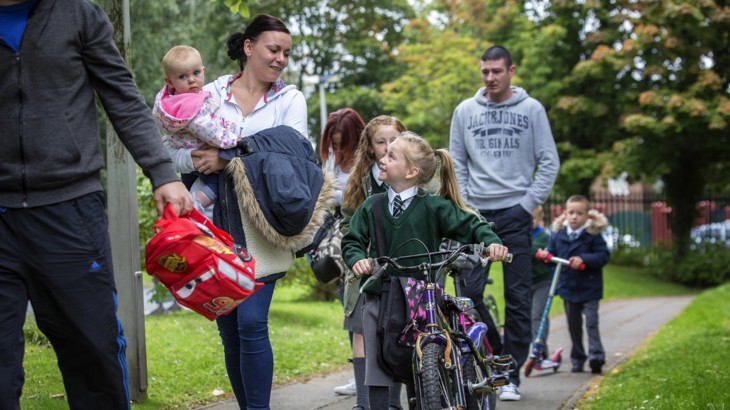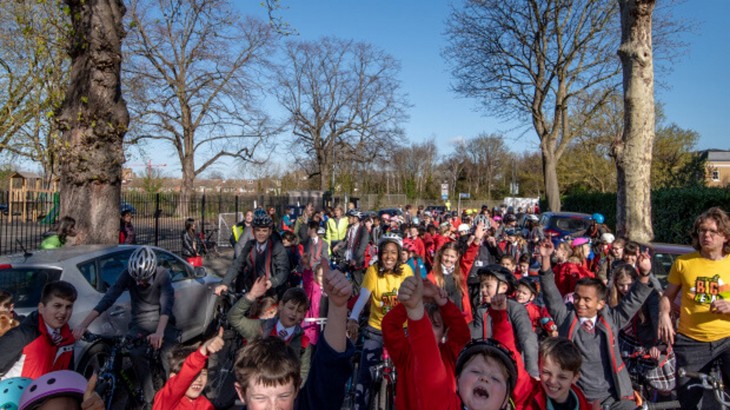Cycling, scooting and walking has many health and environmental benefits. Despite this, 42% of primary school children are driven to school, while congestion and idling car engines pollute the air outside schools across the UK.

Walking and cycling to school creates a safer and healthier environment near schools.
Our recent YouGov poll revealed that nearly two thirds (63%) of teachers want to ban cars on the road outside their school, with a further 26% agreeing that school street closures are an effective measure for bringing down levels of air pollution.
So how can teachers get involved and close their streets to motor vehicles? We caught up with teachers and headteachers across the UK to find out how they have closed their streets to cars for this year’s Big Pedal challenge and why it matters.
Claire Lippiett, Tyn-Y-Wern Primary School, Caerphilly
"We have 242 children attend the main school and also have a small nursery, so you can imagine the chaos that ensues when everyone travels in during the morning and leaves in the afternoon.
"The side street the school is situated on is very small and narrow so cars struggle to turn around as there isn’t enough space. To top it all off, traffic races up and down the main road that connects to the side street and means it can be dangerous for pupils when crossing the road.
“Since we started closing the street to cars, we have seen a huge difference in the environment around the school gates. It’s much less congested, calmer and feels more welcoming. Caerphilly Council has set up a permanent traffic order, where access to the road that leads up to the school is coned off and monitored by a School Crossing Patroller. This works really well.”
Julie Edgecombe, Murrayburn Primary School, Edinburgh
“We want to create a safer and more relaxed atmosphere outside the school. That’s why we’re working hard to discourage parents from driving straight up to the gates at the start and end of the day.
“Our Cycling Officer Kerr and road safety contact at Edinburgh Council have been absolutely brilliant at pushing the application forward for a car-free day. It all went really smoothly and with their help, the tender was approved in good time.
“We hope the one-day street closure raises awareness of the hazards caused by drivers parking on yellow zigzag lines and highlights how easy it can be to park further away and walk, scoot or cycle for the remainder of the journey.

During Big Pedal 2019, 40 school streets were closed.
Donna Berry, St Mary's Church of England Primary School, Southampton
“I think that taking part in the Big Pedal and one-day street closure run by Sustrans, will be a powerful way of showing parents what’s possible when cars are removed from the environment. We hope it will also get them thinking about where they can park other than the road outside of the school.
“We would love to make the road closure outside the school permanent – not just to increase safety but also improve the air quality for our children. We are pushing for a six-week street closure trial in the summer, led by the local council and supported by Sustrans, and hope this will enable us to slowly make the change to a car-free environment.
Claudine Richardson, St Richard Reynolds Catholic College, Twickenham
“At the moment, almost half of our primary school children are driven to school which is something we would like to discourage. This is because the catchment area for the primary years is relatively small, meaning that the children could potentially walk, cycle or scoot the school journey.
“We know this isn’t achievable for everyone but want to encourage parents and pupils to travel actively to school where possible.
"I think it’s a combination of factors that put parents off. There is a lack of cycling infrastructure in the local area, safety fears when walking and cycling on busy main roads and the fact that many parents are so time poor in the morning. This makes jumping in the car seem like the ideal and often the only way to travel.
“Being based in a very residential area and so close to the station means that a more permanent street closure may be difficult. This is because we need to balance the needs of the local community with that of the school and ensure we maintain a happy relationship.
"We’d love to trial the street closure scheme at different times of the year and then go from there based on residents’ feedback.”






